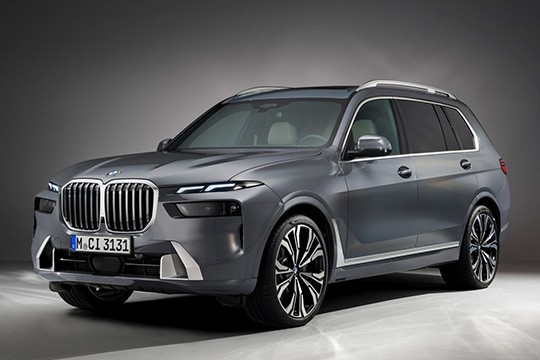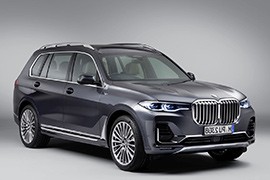BMW X7 Models/Series Timeline, Specifications & Photos
First production year: 2018
Engines: Mild hybrid diesel, Mild hybrid, Diesel, Gasoline
Body style: SUV (Sports Utility Vehicle)
BMW introduced a facelifted version of its flagship SUV, the X7, in 2022 and gave it a reworked look and updated powertrains.
Designed as a premium seven-seat vehicle, the biggest SUV made by the German carmaker from Munchen competed against its classic rival Mercedes-Benz GLS and, on American soil, with Cadillac Escalade. But like the three-pointed-star brand, it came with unibody construction, lowering the overall weight.
The design language was similar to the one found on the 7 Series. It sported a huge kidney-grille design, which raged most of the brand's fans. Actually, only about 20% agreed with them, according to BMW, but they gave it a shot anyway. The full-LED headlights were deeply buried inside the upper side of the bumper and were complemented by daytime running lights above them, like a pair of eyebrows.
Inside, BMW refreshed some of the materials and the technique used. Thus, thanks to the newly developed mats and roof, the cabin ensured superior acoustic comfort. Moreover, the carmaker offered the X7 in a six-seat configuration, with two captain seats in the middle row, while the rearmost passengers were greeted by two comfortable seats.
Like its predecessor, the 2022 X7 was exclusively available as an all-wheel drive vehicle. The powertrains came from either an inline-six turbodiesel or a V8. Both versions were paired to an eight-speed automatic transmission with integrated electric assistance for the mild-hybrid system.
BMW finally decided to enter the 7-seat SUV market with the 2018 X7, a vehicle that was a direct competitor with the Mercedes-Benz GLS and the Audi Q7.
When the BMW launched its first X5 in 1999, it built a factory for that car in the U.S. It was the instant hit of the year. With some technology carried-over from the Land Rover, the X5 sales skyrocketed. Unlike the ML, it featured a unibody bodywork, and that made it lighter. The same goes for the X7, which is, actually, a bigger X5.
The front of the car was the most debatable part of the vehicle. The big grille didn't look like a pair of kidneys anymore. They were just huge with vertical slats that could open and close to help the thermal management of the engine. On the sides, the doors were big enough to allow comfortable access inside.
The cabin was inspired by the 7-Series model, with ample space for every passenger. All of the 7 seats in the car were upholstered in leather. A three-piece glass roof was available, ensuring a light interior and an airy feeling for the passengers. The newly designed display grouping which came as part of the standard-fitted BMW Live Cockpit Professional included a Control Display and a fully-digital instrument cluster of 12.3” each.
For the engine department, the BMW X7 was fitted with two gasoline units and a 3.0-liter diesel offered in two versions, one being fitted with four turbochargers. The standard transmission was an 8-speed automatic.

